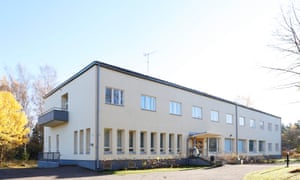↑ Countries define homelessness differently, and count the homeless population in different ways. But what is clear is that homelessness is increasing. Photograph: Justin Lane/EPA

Excellent article and an excellent ambition.
Most people would agree, that achieving a drastic reduction in homlessness in cities is a very “smart” thing to do (even if minimal technology is involved).
![]() by Jon Henley – 10 Dec. 2019
by Jon Henley – 10 Dec. 2019
Homelessness is not inevitable and can be solved – these cities show us how
Big national strategies often struggle to make progress but, from Trieste to Helsinki, individual cities are reducing – and even ending – homelessness
No one knows how many homeless people there are. Countries define homelessness differently; count only those sleeping rough and in shelters on one night night in a year; struggle to estimate those camping with friends or family and living in bad housing or places not meant to be homes.
But what’s clear is the number is increasing. Homelessness and exclusion from housing has now reached crisis point in almost all EU countries, a 2017 Europe-wide report found: families in temporary housing up 50% in London; a 75% rise in youth homelessness in Copenhagen; 37% more sleeping rough in Warsaw.
In the US, according to a White House study published in September, 552,830 people were counted as homeless in January 2018, nearly half of them in California, with 35% sleeping rough and 65% living in some form of shelter. In Australia, homelessness increased by 14% between the 2011 and 2016 censuses.
But homelessness is not an inevitability. While official, government-backed national strategies – where they exist – often struggle to make progress, individual cities are reducing, and even ending, homelessness, showing it need not necessarily be an issue that is too complex, to big or too intractable ever to be solved.
In the US, 85 cities and counties have joined a programme called Built for Zero, with 11 reaching a standard called “functional zero” for chronic or veteran homelessness, meaning people in those populations now become homeless only rarely and for very short periods. Another 47 have achieved measurable reductions.
Its methodology, developed by a non-profit organisation, Community Solutions, is based on the conviction that homelessness is not just a housing, public health or policy issue, but a complex problem that requires everyone working on it to collaborate in counting down, individual by individual, to zero.

A centralised, command-and-control approach, which Community Solutions likens to the coordinated, community-wide surveillance systems that once led, for example, to the eradication of smallpox, is informed by comprehensive, detailed, real-time and by-name data on every person in the community who is homeless.
Only this depth of data will allow communities to really know their homeless people, find appropriate solutions for each one, optimise their resources, develop a successful strategy and share what works with other cities, the organisation believes: it is not just about resources, but devising a faster, smarter, more coordinated system.
“Every person who is homeless in our community that we are aware of goes on our by-name list,” said Jennifer Jaeger, community services director in Rockford, Illinois, which became the first community in the US to reach functional zero for veterans and the second to do so for chronic homelessness.
“Then we get everybody working on the issue and bring them into a room,” she told the New York Times. “We’ll sit down with the list and say: ‘OK, John Smith is number one. Who’s working with him? How do we get him housed as fast as we can?’ It makes a huge difference – they stop being ‘the homeless’ and become people we all know.”
Roseanne Heggarty, president of Community Solutions, says ending homelessness means “getting to a place where it’s rare, brief, and gets solved correctly and quickly when it does happen. That’s a completely achievable end state, we now see.”
Elsewhere, other cities have adopted different approaches. Trieste in northern Italy, close to the Slovenian border, has radically reduced homelessness by focusing on mental health: studies have found up to 45% of US homeless people, for example, have some kind of mental health problem, and up to 25% are seriously mentally ill.
In the 1978, Italy passed new mental health legislation paving the way for state mental hospitals to close and be replaced with a robust network of community-based mental health services instead with an emphasis on respect, social inclusion, community participation and support when needed.

Recognised by the World Health Organisation as global best practice for mental health care, the city, with a population of 240,000, closed its 1,200-bed mental health institution in 1978 and now has only six psychiatric hospital beds in an unlocked ward, with staff in plain clothes.
Severely ill patients needing full-time support live in informal, home-like communal houses; if they leave, staff accompany them to make sure they keep receiving treatment. Involuntary hospitalisation is rare: people with easy access to help, who know and trust their carers, are less prone to reject medication or therapy, so their conditions are less likely to deteriorate.
When things go wrong in Trieste, psychiatrists, not police, are usually first on the scene. Patients, in general, are embraced as full members of the community; many join clubs and take part in communal activities. Employers are urged to hire people with mental health problems and helped when necessary, and family members are encouraged to get involved in their relatives’ recovery.
The Trieste model has received widespread publicity particularly in California; the city was visited as recently as October by a delegation of 40 local and state leaders from Los Angeles with hopes of reforming what many see as a “broken” US system.
At the other end of Europe, the Finnish capital, Helsinki, has pursued a determined Housing First policy that has helped make the country the only one in the EU where homelessness is falling.
A home should be the secure foundation that makes it easier to solve your problems
Juha Kaakinan, Helsinki
“It was clear to everyone the old system wasn’t working; we needed radical change,” said Juha Kaakinen, the first secretary of the working group that devised the policy, who now runs the Y-Foundation developing supported and affordable housing.
“We decided to make the housing unconditional,” says Kaakinen. “To say, look, you don’t need to solve your problems before you get a home. Instead, a home should be the secure foundation that makes it easier to solve your problems.”
With state, municipal and NGO backing, flats were bought, new blocks built and old homeless shelters converted into homes. A total of 3,500 new homes have been created, with support services boosted exponentially to help long-term homeless people with addictions, mental health issues and medical conditions.
The city has invested heavily, too, in homelessness prevention, setting up special teams to advise and help tenants in danger of losing their homes and halving the number of evictions from city-owned and social housing from 2008 to 2016.
As a result, since the programme’s launch in 2008, the number of long-term homeless people in Finland has fallen by more than 35%. Rough sleeping has been all but eradicated in Helsinki, where where winter temperatures can plunge to -20C but only one 50-bed night shelter remains.
Housing First costs money: Finland has spent €250m creating new homes and hiring 300 extra support workers. But studies show the savings in emergency healthcare, social services and the justice system total as much as €15,000 a year for every homeless person in properly supported housing.
Interest in the policy beyond the country’s borders has been exceptional, including in Britain – where 135,000 children are currently homeless, the number of people sleeping rough has risen 165% since 2010, and hidden homelessness has seen 85,000 households placed in temporary accommodation.
Homelessness is, demonstrably, many times more expensive to ignore than it is to solve. For the most vulnerable in society, it is also a matter of life or death – homeless people die, on average, 17 years earlier than those living in proper housing. City-level solutions do, we now know, exist. More need to explore them.
View original article at www.theguardian.com



Also, go to: https://www.weforum.org/agenda/2019/12/how-to-solve-homelessness-poverty-cities-urbanization